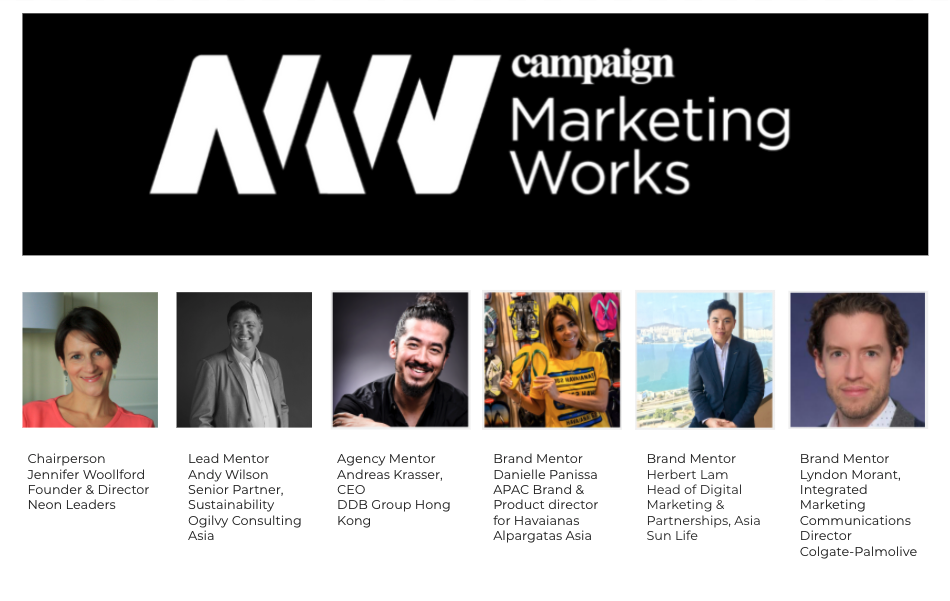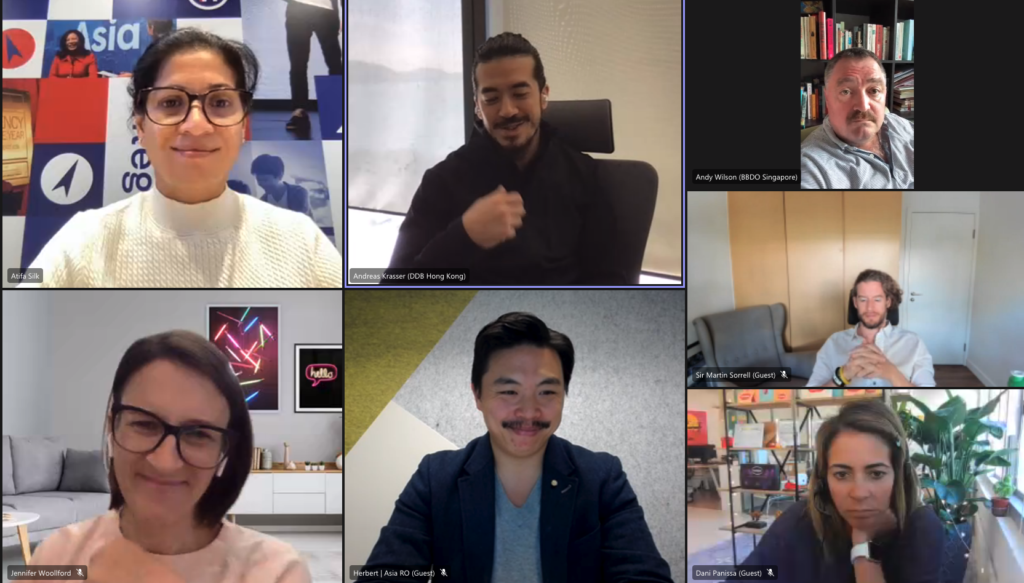
March 9, 2022
How should Perfect Day launch a new brand in Asia?
Read more
December 6, 2021

Originally published in Campaign Asia-Pacific on 2 December 2021. Clockwise from top left: Jennifer Woollford, Andy Wilson, Danielle Panissa, Lyndon Morant, Herbert Lam, Andreas Krasser.
Six mentors from Campaign’s upcoming MarketingWorks event meet to strengthen collaboration between agencies and brands.
This coming February, Campaign Asia-Pacific will host MarketingWorks, a learning experience aimed at improving marketing skills by focusing on better collaboration between clients and agencies. This relationship is perhaps the most critical of partnerships in our industry, and like all professional relationships, is subject to highs and lows. We tend to see the most amazing work when brands and agencies are working in sync. And most often we see mediocrity when they are not.
So how can the two sides work better together? Six top industry mentors from brands and agencies who will be leading the MarketingWorks programme sat down with Campaign Asia-Pacific’s managing director Atifa Silk to flesh out a framework around some of the key issues.
While there are many areas that brands and agencies can work on together, here are five areas Campaign identified from their discussion.
Really understand one another
Let’s start off in the department of the painfully obvious. Of course, both sides need to understand each other’s values and motivations, strengths and weaknesses, goals and objectives in order for all their collective efforts to gel.
For Lyndon Morant, who has long worked agency-side before becoming the director of integrated marketing communications at Colgate-Palmolive, the best outcomes in his career came when all parties worked deeply in sync.
“What’s really special is when folks were navigating towards the same outcome, arm-in-arm, raising each other up, standing on each others’ shoulders and trying to achieve greatness together. And that togetherness is the thing I personally always remember.”
Yet despite the will to do so, this remains one of the hardest things for collaborative teams to achieve, especially now during Covid, Morant says: “That emphasis on speaking the same language—even if our native tongue isn’t the same—but making sure we understand things in the same way, that we all share the same vision and the same values, is super important to get into that work that sticks in the mind forever.”
While a good brief is meant to allow agencies and brands to sing from the same songbook, DDB Hong Kong CEO Andreas Krasser says it still won’t happen without more conversations and clarity.
“Funnily enough, us all being in the communications industry, I think we actually speak different languages when it comes to what constitutes a good brief,” Krasser says. “What really needs to happen is this alignment, a process where we get to this common language.”
Ogilvy Consulting senior partner Andy Wilson agrees. “Before we get into the words and the explicit substance of a brief, I think it’s really important to align assumptions, align vision, align what stake we’ve all got in the game and how invested we are into a successful outcome,” he says. “You can call it teamwork, but it’s more about alignment that is often unspoken. But it’s so critical that all the team from all their perspectives understand deep down where they want to get to, what it means to them, and that will hopefully unlock a huge amount of kind of intensity and effort.”
Once a full team has clarity, understanding and buy-in, it becomes far less likely for a team to lose commitment or suffer dropouts. But sometimes changes to the team can derail this hard-earned understanding, says MarketingWorks chair Jennifer Woollford, the founder and director of NEON Leaders.
“What is often challenging is when the team dynamic changes throughout the process or more senior people get involved later on down the road who haven’t been involved from the outset,” says Woollford, speaking from her experience as a marketing director for Mars. “What has always worked best is when you’re very clear upfront on who the decision-makers are. And those are the people who get on the bus at the beginning and they stay on the bus until the end.”
While the staff switch can often happen at the agency level, it also happens on the brand side as new players get involved. For Daniella Panissa, growth marketing director for Havaianas in APAC, this is one reason why they are now including global marketers in key campaign discussions earlier on.

Create Better Briefs
Having a full understanding from the outset surely helps to create a better brief, MarketingWorks participants say, but getting that brief right is also critical.
“It’s fundamental to the success of the process,” Woollford says. “Without a good, clear and strategically focused brief, the rest of the process can’t flow the way it should flow.”
In fact, according to recent research from the global Better Briefs project, a third of global marketing spend is wasted on poor briefs and misdirected work.
Krasser, who spends a lot of time working with creatives, chalks up many issues with bad briefs to a plain and simple lack of clarity. He explains that when he asks creatives what they want in a brief, their basic answer is: “’Don’t tell me to just go out there and do whatever. I want to know what we’re trying to achieve, what the challenge is, what the is the insight and what is the single-minded proposition.”
This lack of clarity, notes Herbert Lam, Sun Life head of digital marketing and partnerships for Asia, can occur when brands try to do much—to reach multiple objectives all in the same campaign. And if brands don’t catch themselves and agencies don’t challenge the brief, then a big global campaign aimed at differentiation can end up falling into a sea of sameness.
Briefs are intended to ensure there is accountability in executing a campaign, which is important. But when accountability becomes all-important, it spawns other intentions in briefs that are less productive and more about saving face.
“These days I get the sense that writing a good brief is a brief where people have their ass covered,” laments Morant. “[They say:] ‘I put it all in the brief, if the agency screws I up they can’t say it was me.’ And vice-versa the agency says, ‘Look I delivered the brief and if the work sucks, then it’s your fault because you wrote a crappy brief.’ And I see the briefing process move so far away from ‘Let’s have a conversation about how we’re going to change the world’.”
Provide freedom and trust
This brings us to the next key element of a good brand-agency relationship. Rather than slavishly adhering to the terms of a brief in the face of new ideas, “we need to be open,” Panissa says. She explains how sometimes agencies will bring new challenging ideas that are unexpected, but which end up creating better outcomes.
Morant agrees this is highly important: “When we work with creative folks in particular, it’s offering that safe space where no idea is too crazy and [you can] give us your best shot. I’d rather be dialling down craziness than having to dial it all up.”
As long as not too much time is wasted on unreasonable ideas, Panissa says it’s all about fostering a ‘test and learn’ culture. “It’s knowing that sometimes we fail, but if we do, how can we fail fast and with less investment spent. This is part of the process – testing, learning and sometimes failing.”
“That’s a great outcome of good collaboration,” Wilson agrees. “When we feel safe to put ourselves out there, to put our work and our ideas out there without fear of ridicule. Because [otherwise] you’re just going to get safe work.”

Review work productively
So how are clients to remove that fear of ridicule and harsh criticism? A key step is to ensure critical reviews are productive and delivered in a sensitive way.
Woollford recalls participating in a role-reversal exercise in which she worked through the night to present work as an agency might, only to get the most disheartening flat response from those acting on the brand side.
“That feeling has stuck with me throughout because it makes you realise that you are when you’re giving feedback, you are talking to people who have put so much time and energy into [the work],” Woollford says.
Another problem Woollford points out is when feedback cycles lead to everyone in a room feeling they need to add a slightly different point of view, yet somehow expecting this to give the creative team more clarity.
If feedback on the spot isn’t well thought out, Woollford explains, it can be more damaging than good. She suggests thanking presenters for their work, going away and really thinking about it before delivering a more clear and measured review.
Lam also notes that sometimes brands may need to get out of their business suits and into pajamas to try to experience work the way their intended audience might before responding. Otherwise, the review becomes more of a checkbox exercise with brief in hand.
Wilson further suggests that the language of ‘feedback’ sessions is problematic, since it implies a transactional meeting where responses will be ‘fed back’ to the agency, putting the onus for improvement back onto them. He’d rather have these sessions be considered as conversations or discussions about improving the work.
In that vein, Morant suggests it is beneficial to first share what is working, then pose questions to stimulate discussions about the work-in-progress, as opposed to immediately feeding back straight editorial direction.
See the bigger picture
Often, the inability to have a quality conversation and its devolution into straight directives comes from the pressure of tight deadlines and the need for urgency. Krasser says he’s noticed more rather than less of this in recent years.
“Everything is fast, everything is urgent,” he says. “Everybody prioritises the urgent over the important. We often ignore the basics, and collaboration is one of those basics, unfortunately.”
When asked what he would like delegates to get out of the MarketingWorks learning experience, Krasser says he hopes “they get inspired to take a step backwards and take a little bit more of a helicopter view in terms of what it is we are trying to do within the industry. Maybe even to get a bit of a perception change in terms of what is important versus what is urgent and how collaboration, like a partnership, needs time to be nurtured.”
Or as Wilson puts it: “The ideal thing is for everyone to leave this recognising that this is not a typical workflow process. That we’re in the pursuit of something special and elusive and sometimes magic. And in order to stand the best chances of that happening, it needs to be treated in a special way. People, processes and the thinking need to be elevated accordingly. If we leave the session with a renewed respect of the elevated difference of what we’re all trying to achieve in these kinds of exercises I think that would be wonderful.”

Originally published in Campaign Asia-Pacific. Read more at: https://www.campaignasia.com/article/five-ways-marketers-and-agencies-can-work-better-together/474295?utm_source=20211202&utm_medium=newsletter&utm_campaign=ca_daily&mc_cid=45de252695&mc_eid=9bd544a972